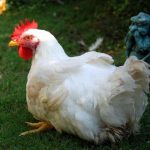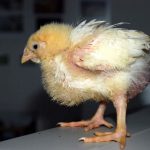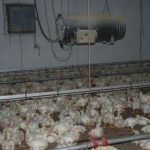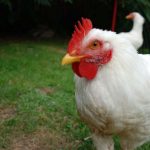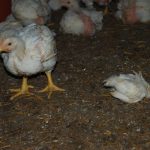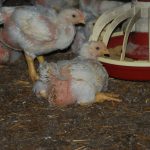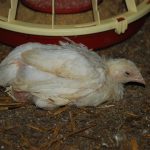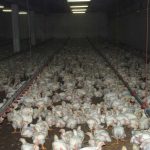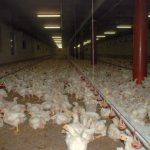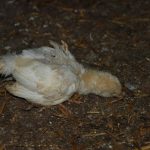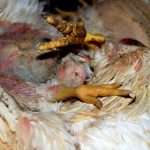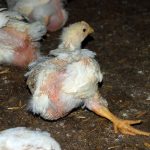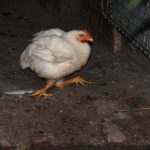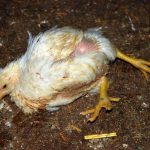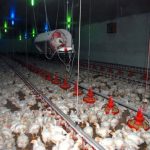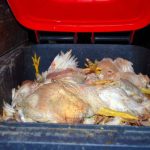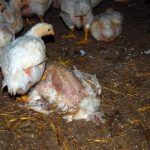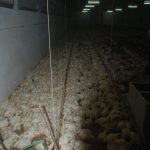Fattened Poultry
Fattened poultry also have a right to live, but they vegetate miserably in dark halls in their thousands.
In the minds of most humans, chicken and turkey meat has become known as being healthy and low in fat. Nobody questions how these animals have to live in their thousands in the tightest of spaces. Lifelong on their own feces, filled through and through with insects – lifelong is easily said though, as these chickens usually don’t get older than five weeks, because then they have already reached their slaughter weight of 1.5 kg.
More than 52 million fattened chickens and 5 million turkeys are being crammed in animal factories in Austria every year. The goal behind this is rapid animal growth, producing lots of meat in a short time frame, whatever the cost might be. In only 35 days the animals reach their slaughter weight, but obviously their bones can not grow equally fast and so all chickens suffer from joint damage and great pain in general. 30% of the animals break their legs before they even reach the slaughterhouse. Painless movements are impossible for these animals, and due to this reason, in the final mast they only sit, or better lie on their chests. Sick animals are no longer able to reach the water dispensers and all that remains is a miserable wait for death.
The government wants to drastically worsen the existing animal protection law regarding fattening chickens and turkeys. A new, drafted regulation would permit 26 broiler chickens per m², instead of 20 per m² that are allowed currently.
In 2004, a new federal animal protection law was unanimously passed in parliament. It enacts a maximum stocking density of 30 kg of chicken per m² of floor area for meat production. At 1.5 kg body weight that is 20 chickens per m² – which is still a lot!
At the end of December 2008, the Ministry of Animal Welfare issued a draft for poultry farming, which envisages an increase in the stocking density of chickens by 30% (up to 38 kg per m²) and for turkeys by a whopping 50% (from 40 up to 58 kg per m²).
I was fortunate enough to be able to nurse four of these afflicted beings back to health from the age of chicks. Three roosters and an almost blind hen lived in my garden in a beautiful outdoor enclosure with huts, trees and lots of sunshine. These animals are extremely social, very smart and absolutely funny birds. They recognize their mistress, walk after her with incredible agility, even though they are huge. They have little in common with normal chickens, they are like little dogs and also as heavy, they live a placid life. They steal like ravens, clear toolboxes and trashcans empty…
Background Knowledge Fattened Poultry (source: vgt.at)
Numbers and Facts
In poultry keeping, automation is at its furthest compared to other livestock farming. The role of the brooding mother is taken away by incubators in oversized hatcheries. After a 21-day incubation cycle around 180,000 eggs can be taken out of the machine . All chicks that did not hatch after exactly 21 days are disposed of in waste disposal units. 15 million broiler chicks and 1.5 million turkey chicks die this way in Austria every year.
More than 52 million broiler chickens and 5 million turkeys are being crammed in poultry factories in Austria every year.
One of the main problems with broilers is the breeding to ensure fast growth, but only of the breast meat and not the bones and joints. In just 35 days, the animals reach the slaughter weight, while the same aged laying hens are still chicks, which grow up only at the age of 140 days. This rapid growth of chickens for fattening means, that without exception, all chickens suffer from joint damage and therefore also from great pain in general. 30% of the animals break their legs before they even arrive at the slaughterhouse. For fattening turkeys, the situation is not much better. Poultry experts speak of so called “breeding of defects”: for these animals, their sheer existence is already agony. It is not possible for them to move or walk without pain.
Legal framework
In chicken fattening a stocking density of 30 kg chicken per m² is allowed, that is about 20 animals. In turkey fattening, even 40 kg of turkey per m² are allowed, which, however, means a smaller number of animals per m², each having a much higher slaughter weight in their case.
Litter is mandatory, but it is spread only once before the animals are put into their cages and then never cleared out again. The chickens and turkeys spend their entire lives in their own feces, with corresponding consequences for their health.
Lays are allowed to cut 1/3 of the beak of chicks that are younger than 10 days without even using anaesthesia. Also, they are allowed to shorten the inbound part of breeding roosters’ phalanges of the toes on their first day after being born.
When buying poultry the next time, think about the life of these creatures, which should and can not really be called life, and refrain from this dubious pleasure.

